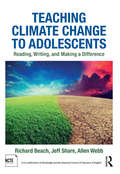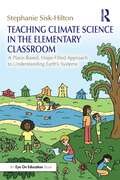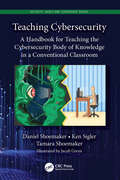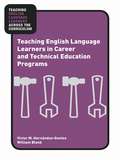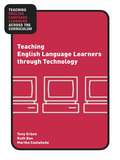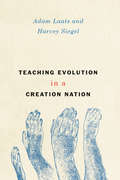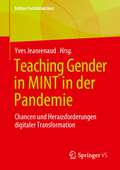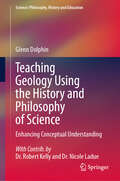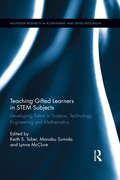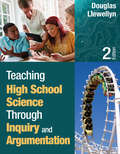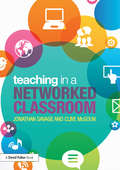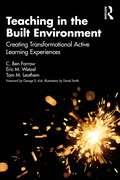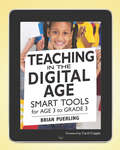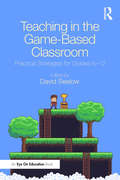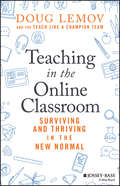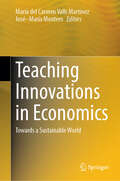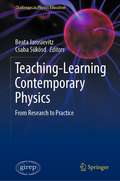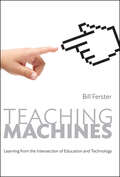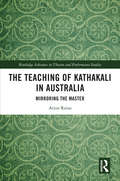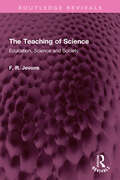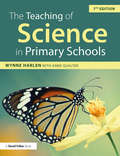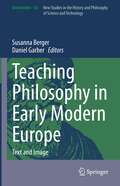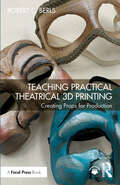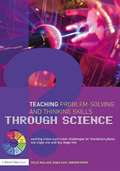- Table View
- List View
Teaching Climate Change to Adolescents: Reading, Writing, and Making a Difference
by Richard Beach Jeff Share Allen WebbCO-PUBLISHED BY ROUTLEDGE AND THE NATIONAL COUNCIL OF TEACHERS OF ENGLISH Teaching Climate Change to Adolescents is THE essential resource for middle and high school English language arts teachers to help their students understand and address the urgent issues and challenges facing life on Earth today. Classroom activities written and used by teachers show students posing questions, engaging in argumentative reading and writing and critical analysis, interpreting portrayals of climate change in literature and media, and adopting advocacy stances to promote change. The book illustrates climate change fitting into existing courses using already available materials and gives teachers tools and teaching ideas to support building this into their own classrooms. A variety of teacher and student voices makes for an appealing, fast-paced, and inspiring read. Visit the website for this book for additional information and links. All royalties from the sale of this book are donated to Alliance for Climate Education.
Teaching Climate Science in the Elementary Classroom: A Place-Based, Hope-Filled Approach to Understanding Earth’s Systems
by Stephanie Sisk-HiltonDiscover new ways to help elementary students engage with and understand the world around them through place-based, hope-filled learning about the causes, impacts, and responses to climate change. This book features foundational climate concepts, easily implementable activity plans, and inspiring examples of student engagement. Each chapter begins with a short vignette pulled from the author’s considerable teaching experience in engaging students in concepts of climate change and climate justice, followed by content-focused sections and recommendations for student activities and projects. The author provides stories of hope-filled action to invite teachers to look for and reflect on similar narratives in their own communities. Sample units of study for grades K-5 show teachers how key ideas from each chapter come together into an instructional plan that incorporates the three dimensions of NGSS and can fit into the broader outline of their school year. This resource is an accessible tool to support any elementary educator in building their own knowledge base and integrating the important and timely issues of climate change into their classroom.
Teaching Cybersecurity: A Handbook for Teaching the Cybersecurity Body of Knowledge in a Conventional Classroom (Security, Audit and Leadership Series)
by Daniel Shoemaker Ken Sigler Tamara ShoemakerLet’s be realistic here. Ordinary K-12 educators don’t know what "cybersecurity" is and could probably care less about incorporating it into their lesson plans. Yet, teaching cybersecurity is a critical national priority. So, this book aims to cut through the usual roadblocks of confusing technical jargon and industry stovepipes and give you, the classroom teacher, a unified understanding of what must be taught. That advice is based on a single authoritative definition of the field. In 2017, the three societies that write the standards for computing, software engineering, and information systems came together to define a single model of the field of cybersecurity. It is based on eight building blocks. That definition is presented here. However, we also understand that secondary school teachers are not experts in arcane subjects like software, component, human, or societal security. Therefore, this book explains cybersecurity through a simple story rather than diving into execution details. Tom, a high school teacher, and Lucy, a middle school teacher, are tasked by their district to develop a cybersecurity course for students in their respective schools. They are aided in this by "the Doc," an odd fellow but an expert in the field. Together they work their way through the content of each topic area, helping each other to understand what the student at each level in the educational process has to learn. The explanations are simple, easy to understand, and geared toward the teaching aspect rather than the actual performance of cybersecurity work. Each chapter is a self-contained explanation of the cybersecurity content in that area geared to teaching both middle and high school audiences. The eight component areas are standalone in that they can be taught separately. But the real value lies in the comprehensive but easy-to-understand picture that the reader will get of a complicated field.
Teaching Electromagnetics: Innovative Approaches and Pedagogical Strategies
by Krishnasamy T. Selvan Karl F. WarnickTeaching Electromagnetics: Innovative Approaches and Pedagogical Strategies is a guide for educators addressing course content and pedagogical methods primarily at the undergraduate level in electromagnetic theory and its applications. Topics include teaching methods, lab experiences and hands-on learning, and course structures that help teachers respond effectively to trends in learning styles and evolving engineering curricula. The book grapples with issues related to the recent worldwide shift to remote teaching. Each chapter begins with a high-level consideration of the topic, reviews previous work and publications, and gives the reader a broad picture of the topic before delving into details. Chapters include specific guidance for those who want to implement the methods and assessment results and evaluation of the effectiveness of the methods. Respecting the limited time available to the average teacher to try new methods, the chapters focus on why an instructor should adopt the methods proposed in it. Topics include virtual laboratories, computer-assisted learning, and MATLAB® tools. The authors also review flipped classrooms and online teaching methods that support remote teaching and learning. The end result should be an impact on the reader represented by improvements to his or her practical teaching methods and curricular approach to electromagnetics education. The book is intended for electrical engineering professors, students, lab instructors, and practicing engineers with an interest in teaching and learning. In summary, this book: Surveys methods and tools for teaching the foundations of wireless communications and electromagnetic theory Presents practical experience and best practices for topical coverage, course sequencing, and content Covers virtual laboratories, computer-assisted learning, and MATLAB tools Reviews flipped classroom and online teaching methods that support remote teaching and learning Helps instructors in RF systems, field theory, and wireless communications bring their teaching practice up to date Dr. Krishnasamy T. Selvan is Professor in the Department of Electronics & Communication Engineering, SSN College of Engineering, since June 2012. Dr. Karl F. Warnick is Professor in the Department of Electrical and Computer Engineering at BYU.
Teaching English Language Learners in Career and Technical Education Programs
by Victor M. Hernández-Gantes William BlankExploring the unique challenges of vocational education, this book provides simple and straightforward advice on how to teach English Language Learners in today's Career and Technical Education programs. The authors' teaching framework and case studies draw from common settings in which career and technical educators find themselves working with ELLs—in the classroom, in the laboratory or workshop, and in work-based learning settings. By integrating CTE and academic instruction, and embedding career development activities across the curriculum, readers will gain a better understanding of the challenges of teaching occupationally-oriented content to a diverse group of learners in multiples settings.
Teaching English Language Learners through Technology
by Tony Erben Ruth Ban Martha CastañedaIn Teaching English Language Learners through Technology, the authors explore the use of computers/technology as a pedagogical tool to aid in the appropriate instruction of ELLs across all content areas. The special focus of this book is on the informed use of various technologies and software programs that can specifically aid ELLs. Strategies are also provided for varying levels of access--whether teachers teach in a one computer classroom, have access to multiple computers, or have the ability to go into a computer lab at their school. A fully annotated list of web and print resources completes the volume, making this a valuable reference to help teachers harness the power of computer-assisted technologies in meeting the challenges of including all learners in effective instruction.
Teaching Evolution in a Creation Nation
by Adam Laats Harvey SiegelNo fight over what gets taught in American classrooms is more heated than the battle over humanity's origins. For more than a century we have argued about evolutionary theory and creationism (and its successor theory, intelligent design), yet we seem no closer to a resolution than we were in Darwin's day. In this thoughtful examination of how we teach origins, historian Adam Laats and philosopher Harvey Siegel offer crucial new ways to think not just about the evolution debate but how science and religion can make peace in the classroom. Laats and Siegel agree with most scientists: creationism is flawed, as science. But, they argue, students who believe it nevertheless need to be accommodated in public school science classes. Scientific or not, creationism maintains an important role in American history and culture as a point of religious dissent, a sustained form of protest that has weathered a century of broad--and often dramatic--social changes. At the same time, evolutionary theory has become a critical building block of modern knowledge. The key to accommodating both viewpoints, they show, is to disentangle belief from knowledge. A student does not need to believe in evolution in order to understand its tenets and evidence, and in this way can be fully literate in modern scientific thought and still maintain contrary religious or cultural views. Altogether, Laats and Siegel offer the kind of level-headed analysis that is crucial to finding a way out of our culture-war deadlock.
Teaching Gender in MINT in der Pandemie: Chancen und Herausforderungen digitaler Transformation (Edition Fachdidaktiken)
by Yves JeanrenaudDer Band widmet sich der Frage, ob und wie sich die Corona-Pandemie auf das Themenfeld Gender in der MINT-Hochschullehre spezifisch auswirkte und weiterhin auswirkt. Dabei werden Aspekte der digitalen Transformation der MINT-Hochschullehre während der Corona-Krise analysiert und Einblicke in die Voraussetzungen, Prozesse und Folgen der Auseinandersetzung mit dem Thema Gender in diesem Zusammenhang beleuchtet.
Teaching Geology Using the History and Philosophy of Science: Enhancing Conceptual Understanding (Science: Philosophy, History and Education)
by Glenn DolphinThis book provides a case study on how to design and build an introductory geology course for non-science majors. The book presents a foundation with the status of geoscience education and research in geoscience conceptual development as a backdrop for the design process. It then describes the instructional goal-setting process and development of the structural components of the course based on the determined goals. The book presents the three historical narratives (the earth is a historical entity, the earth is very old, and the earth is dynamic) that form the foundation of instruction. It also describes examples of the implicit, explicit, and reflective treatments of the nature of science to help student develop a better sense of the process of geology. Finally, the book gives preliminary results from some innovative approaches to research on student learning within the domains of geological content knowledge and NOS content knowledge within the course.
Teaching Gifted Learners in STEM Subjects: Developing Talent in Science, Technology, Engineering and Mathematics (Routledge Research in Achievement and Gifted Education)
by Keith S. Taber Manabu Sumida Lynne McClureThis book offers an overview of programmes designed to support the learning of gifted and talented students in STEM subjects, both to allow them to meet their potential and to encourage them to proceed towards careers in STEM areas. The chapters from a range of national contexts report on perspectives, approaches and projects in gifted education in STEM subjects. These contributions provide a picture of the state of research and practice in this area, both to inform further research and development, and to support classroom teachers in their day-to-day work. Chapters have been written with practitioners in mind, but include relevant scholarly citations to the literature. The book includes some contributions illustrating research and practice in specific STEM areas, and others which bridge across different STEM subjects. The volume also includes an introductory theoretical chapter exploring the implications for gifted learners of how 'STEM' is understood and organized within the school curriculums.
Teaching High School Science Through Inquiry and Argumentation (2nd Edition)
by Douglas J. LlewellynProven ways to teach next generation science! To ensure our students achieve scientific literacy, we need to know what works in science teaching. One thing we know for certain: inquiry and argumentation are key. This groundbreaking book for Grades 9–12 addresses the new direction of science standards by emphasizing both inquiry-based and argument-based instruction. Filled with case studies and vignettes, this edition features: Exceptional coverage of scientific argumentation Enhanced chapters on assessment and classroom management Questioning techniques that promote the most learning Activities that emphasize making claims and citing evidence New examples of inquiry investigations New approaches to traditional labs
Teaching in a Networked Classroom
by Jonathan Savage Clive McGounThe pace of technological change has made the immediate and long-term future difficult, if not impossible, to predict. Teachers are forced to imagine the world they are preparing their students to live in. In this situation creativity becomes a vital resource for enabling uncertain futures to be embraced and an important attribute for students to have both for their learning and their employability in the future. In this book, the authors argue that creativity is a social and collaborative process that can be enhanced through online and digital technologies. Filled with case studies and practical tasks, it shows teachers how they can develop an approach to teaching and learning with digital technologies that is inherently social, collaborative and creative. Including case studies and practical examples of projects and lessons throughout, the chapters cover: Learning in a networked society An examination of sharing practices and how knowledge can be shared more effectively Potential pitfalls of virtual learning environments and public social networking sites Using digital media to plan schemes of work and lessons How to facilitate meaningful collaboration and discussion through digital media Creating online environments to enable students to share their understandings and learning Bringing together key ideas about creativity, collaborative learning and ICT in the classroom, this timely book will be an invaluable resource for all teachers.
Teaching in the Built Environment: Creating Transformational Active Learning Experiences
by C. Ben Farrow Eric Wetzel Thomas LeathemTeaching in the Built Environment: Creating Transformational Active Learning Experiences offers a blueprint for teaching success from an award-winning team of educators, with classroom-ready strategies for maximizing undergraduate learning in built environment disciplines. Drawing on the authors’ years of experience as education researchers and faculty at one of the nation’s top design and construction schools, this primer empowers instructors to implement high impact teaching practices in any educational setting, from intimate seminars to "mega classes" of hundreds of students. Chapters on internships, study abroad, and field experiences equip faculty with teaching tools guaranteed to work on or off campus. Just as importantly, this book identifies the teaching tactics that don’t work. The authors’ candid reflections on their own failed pedagogical experiments help instructors avoid confidence-shaking missteps and encourage them to turn teaching struggles into future successes. A thorough review of the latest education research provides theoretical context and empirical support for strategies direct from the authors’ award-winning classrooms, studios, and labs. Features: Classroom-tested strategies for maximizing undergraduates’ learning in built environment disciplines Adapted teaching methods from the authors’ award-winning classrooms, studios, and labs to any higher education setting An ideal resource for built environment faculty, from first timers to veteran educators The latest research on teaching and learning in design and construction disciplines A must-read for built environment educators, from first-time faculty to classroom veterans, Teaching in the Built Environment: Creating Transformational Active Learning Experiences inspires teaching that will resonate long past the semester’s end.
Teaching in the Digital Age
by Carol Copple Brian PuerlingTechnology is rapidly changing the ways we live our lives and interact with the world. It's also changing how you teach. Technology can enhance your classroom's complete curriculum and assessment and help you create and capture meaningful experiences, support inquiry, and expand your classroom's walls. This comprehensive framework will help you select and use a variety of technology and interactive media tools in your classroom-including digital cameras, audio recorders, webcams, publication and presentation tools, and multi-touch mobile devices.Reflecting Technology in Early Childhood Programs, the joint position statement of the National Association for the Education of Young Children and the Fred Rogers Center, Teaching in the Digital Age: Smart Tools for Age 3 to Grade 3 includesDevelopmentally appropriate and effective strategies to use technology to facilitate children's learning28 links to video clips that provide a deeper look at how these practices are used in real classrooms32 forms to help you plan, reflect on, and evaluate how you use technology to help children learnBrian Puerling, a National Board Certified Teacher and graduate of the Erikson Institute, is the Director of Education Technology at the Catherine Cook School in Chicago. He is a former preschool teacher, a member of the National Association for the Education of Young Children's Tech and Young Children Interest Forum, serves on the Sesame Workshop Teacher Council, is active with the Chicago Metro Association for the Education of Young Children, and is a popular presenter at national conferences.
Teaching in the Game-Based Classroom: Practical Strategies for Grades 6-12
by David SeelowTeaching in the Game-Based Classroom is a hands-on guide to leveraging students’ embrace of video games toward successful school performance. Evidence tells us that game-based learning can help teachers design classes, develop transformative learning tools, and assess progress on multiple levels not dependent on one-size-fits-all bubble sheets. Authored by game-savvy teachers in partnership with classroom-experienced academics, the highly varied chapters of this book are concise yet filled with sound pedagogical approaches. Middle and high school educators will find engaging new ways of inspiring students’ intrinsic motivation, skill refinement, positive culture-building, autonomy as learners, and more.
Teaching in the Online Classroom: Surviving and Thriving in the New Normal
by Doug LemovA timely guide to online teaching strategies from bestselling author Doug Lemov and the Teach Like a Champion team School closures in response to the covid-19 coronavirus pandemic resulted in an immediate and universal pivot to online teaching. More than 3.7 million teachers in the U.S. were suddenly asked to teach in an entirely new setting with little preparation and no advance notice. This has caused an unprecedented threat to children's education, giving rise to an urgent need for resources and guidance. The New Normal is a just-in-time response to educators’ call for help. Teaching expert Doug Lemov and his colleagues spent weeks studying videos of online teaching and they now provide educators in the midst of this transition with a clear guide to engaging and educating their students online. Although the transition to online education is happening more abruptly than anyone anticipated, technology-supported teaching may be here to stay. This guide explores the challenges involved in online teaching and guides educators and administrators to identify and understand best practices. It is a valuable tool to help you and your students succeed in synchronous and asynchronous settings this school year and beyond. Learn strategies for engaging students more fully online Find new techniques to assess student progress from afar Discover tools for building online classroom culture, combating online distractions, and more Watch videos of teachers building rigor and relationships during online instruction The New Normal features real-world examples you can apply and adapt right away in your own online classroom to allow you to survive and thrive online.
Teaching Innovations in Economics: Towards a Sustainable World
by María del Carmen Valls Martínez José–María MonteroThis book highlights the latest technological innovations in economics education. Economics, as a discipline, not only studies the relationship between ends and scarce means, which can be used alternatively, but also serves as a social science that uses historical data to predict future events—a task complicated by the influence of human behavior. In economics, a solid theoretical foundation alone is insufficient; practical application requires a deep understanding of statistics. With the vast amount of information available today, data processing is now performed using specialized software. Consequently, teaching economics demands a wide range of complex skills that have significantly evolved in recent years, driven by the growing interest in educational innovation among professors and scientists, further accelerated by advancements in new technologies. Moreover, economics education is increasingly aligned with the global concern for sustainability, as emphasized in the United Nations' Agenda 2030. Professors are now integrating sustainability into syllabi and teaching methodologies. This book covers key topics such as: Technological and innovative advancements in economics education. New teaching-learning theories and models in economics education. The impact of digital transformation on economics education. The role of artificial intelligence in economics education. Addressing special educational needs in economics education. Evaluation of the teaching-learning process in economics. Assessment of student learning in economics. Development of materials and tools for economics education. Final projects (Undergraduate and Master's) in economics. Authored by leading professors and researchers in the field, this book presents a collection of chapters that rigorously explore teaching innovations in economics.
Teaching-Learning Contemporary Physics: From Research to Practice (Challenges in Physics Education)
by Beata Jarosievitz Csaba SükösdThis book presents research contributions focussing on the introduction of contemporary physics topics – mainly, but not exclusively, quantum physics – into high school currciula. Despite the important advances and discoveries in quantum physics and relativity which have revolutionized our views of nature and our everyday lives, the presence of these topics in high school physics education is still lacking. In this book physics education researchers report on the teaching and learning of quantum physics from different perspectives and discuss the design and use of different pedagogical approaches and educational pathways. There is still much debate as to what content is appropriate at high school level as well what pedagogical approaches and strategies should be adopted to support student learning. Currently there is a greater focus on how to teach modern physics at the high school level rather than classical physics. However, teachers still lack experience and availability of appropriate teaching and learning materials to support the coherent integration of Quantum Physics in high school curricula. All of the 19 papers presented in this book discuss innovative approaches for enhancing physics education in schools.
Teaching Machines: Learning from the Intersection of Education and Technology (Tech.edu: A Hopkins Series on Education and Technology)
by Bill FersterTechnology promises to make learning better, cheaper, faster—but rarely has it kept that promise.The allure of educational technology is easy to understand. Classroom instruction is an expensive and time-consuming process fraught with contradictory theories and frustratingly uneven results. Educators, inspired by machines’ contributions to modern life, have been using technology to facilitate teaching for centuries.In Teaching Machines, Bill Ferster examines past attempts to automate instruction from the earliest use of the postal service for distance education to the current maelstrom surrounding Massive Open Online Courses. He tells the stories of the entrepreneurs and visionaries who, beginning in the colonial era, developed and promoted various instructional technologies. Ferster touches on a wide range of attempts to enhance the classroom experience with machines, from hornbooks, the Chautauqua movement, and correspondence courses to B. F. Skinner’s teaching machine, intelligent tutoring systems, and eLearning. The famed progressive teachers, researchers, and administrators that the book highlights often overcame substantial hurdles to implement their ideas, but not all of them succeeded in improving the quality of education. Teaching Machines provides invaluable new insight into our current debate over the efficacy of educational technology.
The Teaching of Kathakali in Australia: Mirroring the Master (Routledge Advances in Theatre & Performance Studies)
by Arjun RainaThis book tells the story of teaching Kathakali, a seventeenth century Indian dance-drama, to contemporary performers in Australia. A rigorous analysis and detailed documentation of the teaching of multiple learners in Melbourne, both in the group workshop mode and one-on-one, combined with the author’s ethnographic research in India, leads to a unique insight into what the author argues persuasively is at the heart of the art’s aesthetic- a practical realisation of the theory of rasa as first articulated in the ancient Sanskrit treatise on drama The Natyashastra. The research references the latest discoveries in neuroscience on ‘mirror neurons’ and argues for a reconceptualization of Kathakali’s imitative methodology, advancing it from the reductive category of ‘mimicry’ to a more contemporary and complex mirroring which is where its value lies in Australian actor performer training. The Teaching of Kathakali in Australia will be of great interest to students and scholars of theatre and dance, intercultural actor training, practice-led research, and interdisciplinary studies of neuroscience and performance.
The Teaching of Science: Education, Science and Society (Routledge Revivals)
by F. R. JevonsFirst published in 1969, The Teaching of Science primarily deals with science teaching in secondary schools and universities but its searching discussion of criteria concerns all who have to do with education. The concise but well-documented treatments of the nature of the scientific process and of the social implications of science will be of interest to many scientists and especially useful for teachers of general studies. Professor Jevons looks first at why we should teach science and thereby sheds light on the more immediately practical problems of how it should be done. He thus does more than merely add to the already large volume of exhortation to make it more attractive and intellectually stimulating.
The Teaching of Science in Primary Schools
by Wynne Harlen ObeNow in a fully updated seventh edition, The Teaching of Science in Primary Schools provides essential information for students, trainee, and practising teachers about the why, what and how of teaching primary science. Paying particular attention to inquiry-based teaching and learning, the book recognises the challenges of teaching science, and provides suggestions and examples aimed to increase teachers’ confidence and pupils‘ enjoyment of the subject. This new edition explores: Changes in curriculum and assessment requirements in the UK Advances in knowledge of how children learn Expansion in the use of ICT by teachers and children And expands on key aspects of teaching including: The compelling reasons for starting science in the primary school Strategies for helping children to develop understanding, skills and enjoyment Attention to school and teacher self-evaluation as a means of improving provision for children’s learning. Giving the latest information about the rationale for and use of inquiry-based, constructivist methodology, and the use of assessment to help learning, the book combines practice and theory, explaining and advocating for particular classroom interactions and activities. This book is essential reading for all primary school teachers and those engaged in studying primary education.
Teaching Philosophy in Early Modern Europe: Text and Image (Archimedes #61)
by Daniel Garber Susanna BergerThis book examines how philosophy was taught in the early modern period in Europe. It breaks new ground in a number of ways. Firstly, it seeks to bring text-based scholars in the history of philosophy together with social and cultural historians to examine the interaction between tradition and innovation in the early modern classroom, the site where traditional views of the world were transmitted to the generation that was to give birth to modern philosophy and science. Secondly, it draws together scholars who are centered on ideas and words with other scholars who focus on the role of images in the classroom and the intellectual world in this central period of history. The volume advances our understanding of how philosophy was understood and transmitted in this rich and crucial era. The principal audience for Teaching Philosophy are historians of science, philosophy, art, visual culture, and print culture. The chapters are written in a tone accessible to upper-level undergraduates and graduate students. It also reaches non-specialist readers interested in subjects including the “scientific revolution,” the organization of information, and Renaissance and Baroque visual art.
Teaching Practical Theatrical 3D Printing: Creating Props for Production
by Robert C. BerlsTeaching Practical Theatrical 3D Printing: Creating Props for Production is a cohesive and practical guide for instructors teaching 3D printing techniques in stagecraft, costume and props courses.Written for the instructor, this book uses non-technical language to explain 3D printers, their workflows and products. Coverage includes the ins and outs of multiple filaments, pros and cons of different types of printers, shop or laboratory setup and safety concerns. The book features lesson plans, rubrics and class-tested sample student projects from design to finished product that highlight learning objectives and methodologies, as well as software and hardware usage explanations and common problems that can occur within design and printing. Step-by-step instructions are included for many types of projects, including fake noses, candlestick phones, buttons, 3D scans, historical recreations and linear actuators. The book also contains examples of poor, average and excellent work with grading explanations and guidance on how to help the student move to the next level with their projects. Chapter objectives, chapter summaries, checklists and reflection points facilitate an instructor in gaining confidence with 3D printers and incorporating their use in the classroom.Teaching Practical Theatrical 3D Printing is an excellent resource for instructors of Props and Costume Design and Construction courses that are interested in using state of the art tools and technology for theatre production.Fully editable files for every object featured in the book are available at www.routledge.com/9781032453279, allowing readers to jump-start their projects and giving them the flexibility to change and redesign the items to best fit their needs.
Teaching Problem-Solving and Thinking Skills through Science: Exciting Cross-Curricular Challenges for Foundation Phase, Key Stage One and Key Stage Two
by Andrew Berry Belle Wallace Diana CaveThis highly practical resource book presents ways in which teachers can help to develop children's problem-solving and thinking skills through a range of exciting science topics. The book contains classroom-based activities which have been trialled and evaluated by teachers and children, and helpfully shows how the skills developed through rigorous scientific investigations can be used across all areas of the curriculum. The scientific curriculum requirements are extended with exciting and inspiring problem-solving activities that use scientific skills, for example: fair-testing pattern-seeking surveying classifying and identifying investigations over time designing testing and adapting an artefact open-ended exploration The book contains learning objectives for each activity, step by step guidelines for carrying out each problem-solving activity, basic equipment that's needed, examples of learner's work and guidelines for assessment. This book is a must-buy for all early years and primary school teachers keen to encourage an inclusive but differentiated approach to the development of problem-solving and thinking skills in their pupils.
